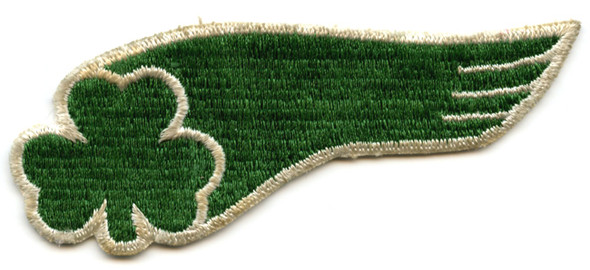Description
ARTIFACT:
VINTAGE:
View AllClose
This is an extremely Rare WWII, circa 1944, US Army Air Forces 416th Night Fighter Squadron Jacket Patch. The patch was hand made in Italy with Silk Embroidery over cardboard planchets on a heavy woven wool background. The patch was obviously combat worn and removed from a flight jacket as it is lightly to moderately soiled and worn. This Iconic Patch shows the cloaked specter of Death, pointing a White Owl forward into combat. The Owl carries a Thompson Sub Machine Gun. The figures are superimposed on a black night sky with yellow stars and a crescent moon, and a blue cloud, all encircled by a thick pale red border.
The Squadron was constituted as the 416th Night Fighter Squadron on 17 Feb 1943, activated on 20 Feb 1943, and inactivated on 9 Nov 1946.
After completing its initial training by April 1943, the squadron crossed the Atlantic on the RMS Queen Elizabeth and landed in the United Kingdom on 11 May. Pausing briefly for training under VIII Fighter Command the Squadron was attached to the Royal Air Force (RAF) for familiarization in theater night fighter techniques. There, it was equipped with RAF Bristol Beaufighters through a Reverse Lend-Lease program until an American aircraft could be produced. Upon arrival in England the squadron received additional training with Royal Air Force night fighter units at several bases in early 1943 achieving the first victory on 24 July. Through the summer, they conducted daytime convoy escort and strike missions, but thereafter flew primarily at night.
The unit then moved to North Africa for operations with Twelfth Air Force. There, the squadron fell under the operational control of the Northwest African Coastal Air Force, a Combined allied organization with British, Free French, and other American units. It carried out defensive night patrols over Allied held territory during the North African campaign, and also conducted night interdiction raids on German positions in Algeria and Tunisia.
The defeat of German, Italian, and Vichy French forces in North Africa allowed the 416th to move with other allied forces into Italy in September 194During its first year there, the squadron patrolled harbors and escorted shipping; however, in September 1944 the 416th shifted to more aggressive activities to provide defensive cover for the American Fifth Army and make intruder sweeps into enemy territory. It also continued defensive patrols and offensive night attacks on Axis positions on Sardinia, Corsica, and in Southern France.
Airborne radar systems technology was advancing in the United States, Germany and Great Britain by early WWII. The initial attempts to develop a usable Allied night fighter system turned to modifications of existing airframes and saw variations of the Defiant, Beaufighter, Mosquito and American A-20, all flown by the RAF. The USAAF directed its attentions to the interim P-70 and P-38, and to the new P-6In 1941 a contract was awarded to the Northrop Corp. for the design and construction of the P-61 Black Widow, the first U.S. aircraft designed from the drawing board as a night fighter. Lacking sufficient suitable aircraft from U.S. sources, USAAF units acquired and operated the British Beaufighter -- and later the Mosquito -- with good success in the European theater. In the Pacific, night fighter squadrons operated the P-70 versions of the Douglas A-20 until P-61s could be delivered in 194By the end of the war, the P-61 was the standard USAAF night fighter and was in service with as many as 16 USAAF Night Fighter Squadrons operating in combat theaters.
ASSIGNMENTS. Air Defense Department, AAF School of Applied Tactics, 20 Feb 1943; VIII Fighter Command (attached to RAF), 11 May 1943; Twelfth Air Force, 8 Aug 1943 (attached to Northwest African Coastal Air Force, 8 Aug 1943; Tunis Fighter Sector, G, August 1943; Bone Fighter Sector, 17 Aug-15 Sep 1943; 286 Wing, RAF, 28 Sep 1943); 62nd Fighter Wing, 28 Jan 1944 (detachments attached to 6505th Fighter Control Area [Prov], 27 Jun-4 Sep 1944; 63rd Fighter Wing, 14-23 Aug 1944, 6504th Fighter Control Area [Prov], 1-13 Sep 1944, 6502nd Fighter Control Area [Prov], 1-14 Sep 1944, 425th Night Fighter Squadron, 4 Jan-20 Feb 1945); XXII Tactical Air Command, 1 Apr 1945; 70th Fighter Wing, 17 Aug 1945.
STATIONS. Orlando AB, Fla, 20 Feb-26 Apr 1943; Honiley, England, 13 May 1943 (detachments at Cranfield, England, 13 May - 10 June 1943; Usworth, England, 13 May-io Jun 194.3; Bath, England, 13 May-io Jun 1943; Bristol, England, 14 May - 4 Jun 1943); Acklington, England, 11 Jun-c. 4 Aug 1943; Algiers, Algeria, c. 8 Aug 194.3; Bone, Algeria, 17 Aug 1943; Bizerte, Tunisia, 15 Sep 1943; Catania, Sicily, 21 Sep 1943; Lecce, Italy, 27 Sep 1943; Grottaglie, Italy, 30 Sep 1943 (detachment at Reghaia, Algeria, 27 Dec 1943-25 Jan 1944); Pomigliano, Italy, c. 28 Jan 1944 (detachments at Tre Cancello Landing Strip, Italy, 14 Jun-8 Jul 1944; Tarquinia, Italy, 8 Jul-4 Sep 1944; Alghero, Sicily, 14-22 Aug 1944; Borgo, Corsica, 14-23 Aug 1944); Rosignano, Italy, c. 1 Sep 1944 (detachment at Pomigliano, Italy, i-g Sep 1944); Pisa, Italy, c. 1 Oct 1944 (detachment at Etain, France, 4 Jan-20 Feb 1945); Pontedera, Italy, 27 Mar 1945; Horsching, Austria, 13 Aug 1945.
AIRCRAFT. A-20, 1943; P-70, 1943; Beaufighter, 1943-1944; Mosquito, 1944-1945; 44-36, 1945; P-61, 1945-1946
OPERATIONS. Combat in MTO and ETO, 4 Sep 1943-3 May 1945.
CAMPAIGNS. Naples-Foggia; Anzio; Rome-Arno; Southern France; North Apennines; Rhineland; Ardennes-Alsace; Po Valley; Air Combat, EAME Theater.
World War II.
SIZE:Approximately 5-1/2" in diameter.
CONSTRUCTION / MATERIALS:Fully-embroidered patch in multi-colored silk/cotton threads.
ATTACHMENT:To be sewn on.
MARKINGS:N/A.
ITEM NOTES:This is from a United States Air Force jacket patch collection which we will be listing more of over the next few month. MEJJM23 LAFGEX08/27/23 hldSAFAEX08/23 depVCJJX08/30/23
CONDITION:6+ (Fine - Very Fine): The patch was obviously combat worn and removed from a flight jacket as it is lightly to moderately soiled and worn.
GUARANTEE:As with all my artifacts, this piece is guaranteed to be original, as described.









